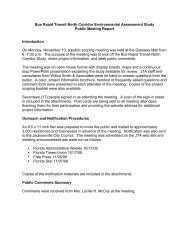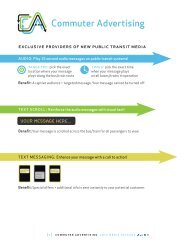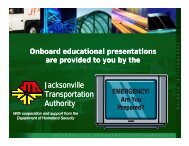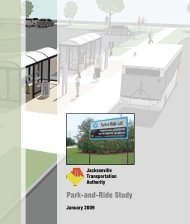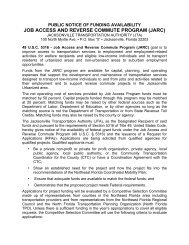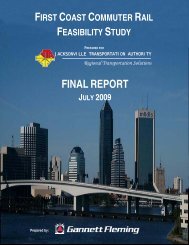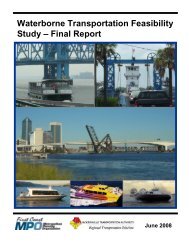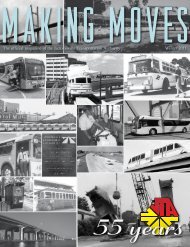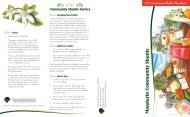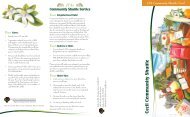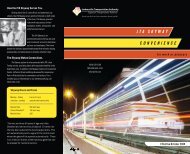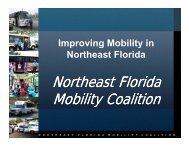Policy Framework - Jacksonville Transportation Authority
Policy Framework - Jacksonville Transportation Authority
Policy Framework - Jacksonville Transportation Authority
You also want an ePaper? Increase the reach of your titles
YUMPU automatically turns print PDFs into web optimized ePapers that Google loves.
City of <strong>Jacksonville</strong><br />
<strong>Policy</strong> <strong>Framework</strong> for Transit-Oriented Development<br />
Monorail “Skyway”<br />
Automated monorail systems are fixed transit facilities<br />
that operate on elevated guideways. The elevated<br />
design allows monorails to be routed directly to<br />
specific activity centers in a given service area without<br />
having to conform to, or compete with, established<br />
travel right-of-way. This “automated people mover”<br />
transit technology is designed to enhance mobility<br />
in targeted areas of intense activity such as core<br />
business districts, airport hubs, or entertainment/<br />
campus facilities. Activity centers served by monorail<br />
typically have very high levels of investment, or urban<br />
development, that warrant the higher investment in<br />
transit.<br />
In <strong>Jacksonville</strong> the JTA operates the 2.5-mile Skyway,<br />
a fully automated transit system operating on an<br />
elevated dual guideway. Nine two-car trains serve<br />
eight stations on both sides of the St. Johns River<br />
and in the central business district. Station spacing<br />
for monorails is variable and depends on the specific<br />
activity centers of a service area. The Skyway system<br />
is interconnected with JTA’s free Trolley service,<br />
providing riders with expanded mobility in the<br />
downtown area linking specific destinations such as<br />
the Prime Obsorne Convention Center, the Florida<br />
State College (FSC) and San Marco. The JTA<br />
Skyway is one of seven urban “automated people<br />
mover” systems that were built in the U.S. beginning<br />
in the 1970s. The other six major urban systems<br />
are in Detroit, Michigan; Irving, Texas; Miami,<br />
Florida; Las Vegas, Nevada; Indianapolis, Indiana;<br />
and Morgantown, West Virginia. Monorail “people<br />
mover” systems are also installed at amusement parks<br />
(Disney) and major airports (Dallas-Fort Worth)<br />
throughout the country.<br />
Streetcar<br />
Streetcars serve a similar function to local buses,<br />
meeting localized travel demand over short distances.<br />
Service is generally frequent and there are a variety<br />
of vehicle types from historic and vintage streetcars<br />
to modern cars. Modern cars have higher passenger<br />
capacities, multiple doors and low floors for quick<br />
boarding and alighting, and generally rely on ticket<br />
vending machines at platforms to manage fare<br />
collection. Because of these attributes, the modern<br />
20 | Transit Technologies<br />
Monorail “Skyway”<br />
Service Area:1/4 mile to 1 mile<br />
Station Spacing: 1/8 mile to 1/4 mile<br />
Optimal Transit Shed: 5 miles to 10 miles<br />
Street Car Characteristics




